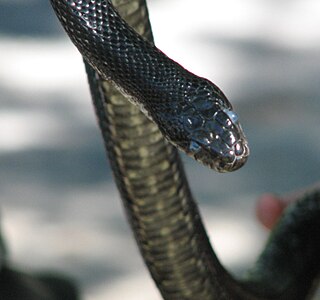
The smooth green snake is a species of North American nonvenomous snake in the family Colubridae. The species is also referred to as the grass snake. It is a slender, "small medium" snake that measures 36–51 cm (14–20 in) as an adult. It gets its common name from its smooth dorsal scales, as opposed to the rough green snake, which has keeled dorsal scales. The smooth green snake is found in marshes, meadows, open woods, and along stream edges, and is native to regions of Canada, the United States, and northern Mexico. A non-aggressive snake, it seldom bites and usually flees when threatened. It mates in late spring to summer, and females lay their eggs from June to September. The smooth green snake will often bob its head in order to mimic vegetation blowing in the wind.

Leptophis ahaetulla, commonly known as the lora or parrot snake, is a species of medium-sized slender snake of the family Colubridae. It is endemic to Central America and northern South America.

Boiga dendrophila, commonly called the mangrove snake or the gold-ringed cat snake, is a species of rear-fanged venomous snake in the family Colubridae. The species is endemic to southeast Asia. It is one of the biggest cat snake species, averaging 6–7 feet in length. It is considered mildly venomous. Although moderate envenomations resulting in intense swelling have been reported, there has never been a confirmed fatality.

The Indian egg-eating snake or Indian egg-eater is a rare species of egg-eating snake in the family Colubridae. The species is endemic to the Indian subcontinent. It is also called Westermann's snake, reflecting its scientific name. The snake belongs to the monotypic genus Elachistodon.

Sibynophis sagittarius, commonly known as Cantor's black-headed snake after Theodore Cantor, is a species of snake endemic to South Asia.

Opheodrys aestivus, commonly known as the rough green snake, is a nonvenomous North American colubrid. It is sometimes called grass snake or green grass snake, but these names are more commonly applied to the smooth green snake. The European colubrid called grass snake is unrelated. The rough green snake is docile, often allowing close approach by humans, and seldom bites. Even when bites occur, they have no venom and are harmless.

Philodryas chamissonis, commonly known as the Chilean green racer and the Chilean long-tailed snake, is a species of moderately venomous opisthoglyphous (rear-fanged) snake in the family Colubridae. The species is endemic to Chile.

Boiga drapiezii, commonly known as Drapiez's cat snake and the white-spotted cat snake, is a species of long and slender rear-fanged snake in the family Colubridae. The species is native to Maritime Southeast Asia and is common throughout its range.

Dendrelaphis punctulatus, also known commonly as the Australian tree snake, the common tree snake, and the green tree snake, is a species of slender, large-eyed, diurnal, non-venomous snake in the family Colubridae. The species is native to many parts of Australia, especially in the northern and eastern coastal areas, and to Papua New Guinea.

Coronella girondica, commonly known as the southern smooth snake or Riccioli's snake, is a species of harmless snake in the family Colubridae. The species is endemic to southern Europe and northern Africa. No subspecies are recognized as being valid.

Kirtland's snake is a threatened or endangered North American species of nonvenomous snake of the subfamily Natricinae, of the family Colubridae. It is the only species in the genus Clonophis.

The striped whipsnake is a species of nonvenomous snake in the family Colubridae. It is closely related to the California whipsnake. The striped whipsnake is native to the western United States and adjacent northern Mexico.

The northern redbelly snake is a nonvenomous snake in the family Colubridae, a subspecies of Storeria occipitomaculata. It is sometimes referred to as a fire snake. It is native to North America.

Boiga barnesii is a species of cat snake endemic to Sri Lanka. It is known as Barnes' cat snake in English and panduru mapila-පදුරු මාපිලා in Sinhala. It is a member of the snake family Colubridae. It is distributed in the lowlands and midlands up to approximately 600 m (2,000 ft) above sea level, with known localities include Matale, Kandy, Gannoruwa, Gampola, Ambagamuwa, Balangoda, Labugama and Sinharaja Rain Forest. Barnes' cat snake is mainly a forest-dwelling species but may occasionally be found in human habitats. It is the smallest cat snake in Sri Lanka and grows up to a maximum of about 600 mm (24 in) in snout-vent length. Being a nocturnal and an arboreal hunter, it mainly feeds on agamid lizards and geckos. The day time is usually spent inside a tree hole or a crevice. It’s a very timid and a mildly venomous snake and rarely attempts to bite.

Leptophis mexicanus, commonly known as the Mexican parrot snake, is a species of medium-sized slender snake in the family Colubridae. The species is endemic to the Americas.

Leptophis is a genus of colubrid snakes, commonly known as parrot snakes. The species within this genus are widely distributed throughout Mexico, Central and South America.

Leptophis modestus, commonly known as the cloud forest parrot snake, is a species of medium-sized slender snake of the family Colubridae. It is endemic to Mesoamerica. There are currently no recognized subspecies.

Leptophis diplotropis, commonly known as the Pacific Coast parrot snake, is a species of snake in the family Colubridae. The species is endemic to Mexico.

Pantherophis alleghaniensis, commonly called the eastern rat snake, is a species of nonvenomous snake in the family Colubridae. The species is endemic to North America.

Thamnosophis stumpffi, commonly known as the yellow-striped water snake, is a species of snake in the subfamily Pseudoxyrhophiinae of the family Pseudoxyrhophiidae. The species is endemic to Madagascar.




















